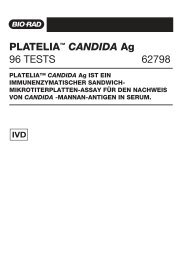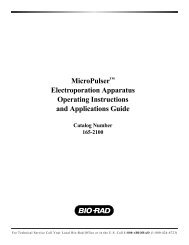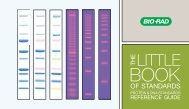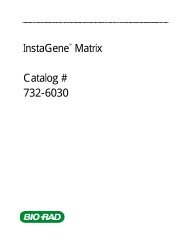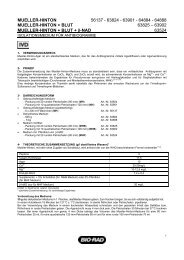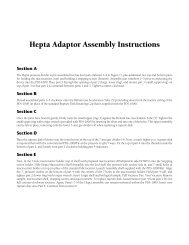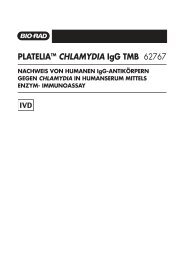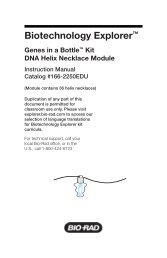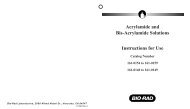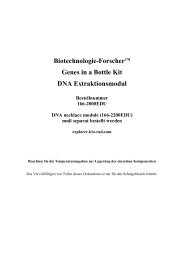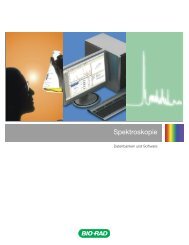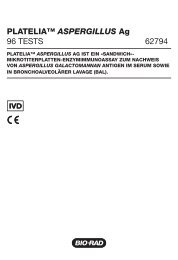Protein Expression and Purification Series - Bio-Rad
Protein Expression and Purification Series - Bio-Rad
Protein Expression and Purification Series - Bio-Rad
You also want an ePaper? Increase the reach of your titles
YUMPU automatically turns print PDFs into web optimized ePapers that Google loves.
<strong>Protein</strong> <strong>Expression</strong> <strong>and</strong> <strong>Purification</strong> <strong>Series</strong><br />
Fractionation range – For size exclusion chromatography gels, the fractionation range is the range of<br />
molecular weights that will enter the gel. A fractionation range of 1,000–6,000 kD will have pores large<br />
enough for molecules in that size range to pass through. Molecules larger than 6,000 kD will be excluded<br />
from entering the gel. The fractionation range is sometimes referred to as the “exclusion limit.”<br />
Frit – Bed support of the chromatography column.<br />
Gel electrophoresis – Technique used to separate, or sieve, molecules that carry electric charges. The<br />
molecules separate from each other according to the different rates at which they migrate through an<br />
electric field set up in a gel that is soaked in a chemical solution.<br />
Glycoslyation – An enzymatic process that adds glycans, or sugars, to a protein or other organic<br />
molecule. Glycosylation is known to aid in protein folding.<br />
GST-tag – Glutathione-s-transferase, an enzyme that binds to the substrate glutathione, is a small amino<br />
acid sequence (27 kD mw) that is added to the sequence of a recombinant protein. Glutathione is bound to<br />
chromatography resin <strong>and</strong> thus used to purify proteins with the GST-tag. GST is also added to recombinant<br />
proteins to aid in solubility.<br />
His-tag – A series of histidine residues (usually 6) fused to a protein that aids protein purification because<br />
of its strong binding to nickel (IMAC) columns. Also known as a “polyhistidine tag.”<br />
Hydrophilic – A molecule that has a strong affinity for water, “water loving.”<br />
Hydrophobic – A molecule that has a strong dislike for or is insoluble in water, “water fearing.”<br />
Hydrophobic interaction chromatography – A chromatography method that separates molecules<br />
based on their level of hydrophobicity.<br />
IMAC – Immobilized Metal Affinity Chromatography; a chromatography method where the affinity of<br />
histidines to metals, such as nickel, is used to purify proteins tagged with polyhistidine sequences.<br />
Inclusion body – Aggregated <strong>and</strong> precipitated expressed proteins found inside bacteria induced to make<br />
high levels of recombinant protein.<br />
Insoluble – The parts of the cell that are not dissolved in water or buffer.<br />
Ion exchange chromatography – A chromatography method where the charge of the molecule is<br />
exploited to bind to oppositely charged chromatography media.<br />
Isoelectric point – (pI) The pH at which a molecule has a net charge of 0.<br />
Laemmli sample buffer – The first, <strong>and</strong> most common, sample buffer used for protein electrophoresis.<br />
First described in 1970, this buffer consists of 62.5 mM Tris buffer to maintain pH conducive to<br />
electrophoresis; 10% glycerol to increase density of the protein so that it stays sunk in the gel well, 2%<br />
SDS to equalize the protein charge; 5% DTT (or BME) can be added to reduce disulfide bonds in the<br />
protein; <strong>and</strong> 0.01% bromophenol blue, which gives the sample color.<br />
Lig<strong>and</strong> – A molecule, such as an antibody, enzyme, or protein tag, with specific affinity for another<br />
molecule.<br />
Loading buffer – (Equilibration buffer) The buffer used to add sample to a chromatography column.<br />
The loading buffer is formulated to exploit properties of the biomolecule of interest for the particular<br />
chromatography resin <strong>and</strong> allows the biomolecule to bind to the resin.<br />
Appendix I: Glossary<br />
243<br />
APPENDIX I<br />
GLOSSARY




